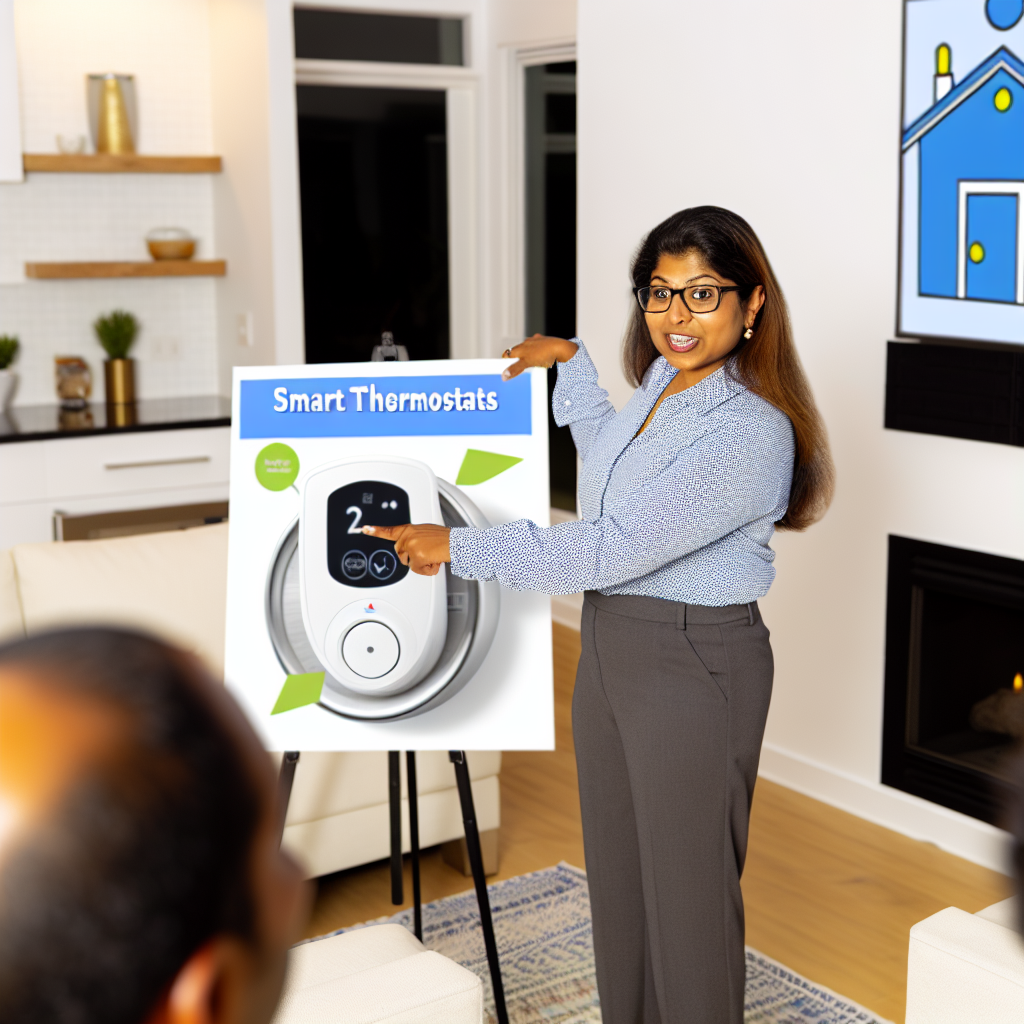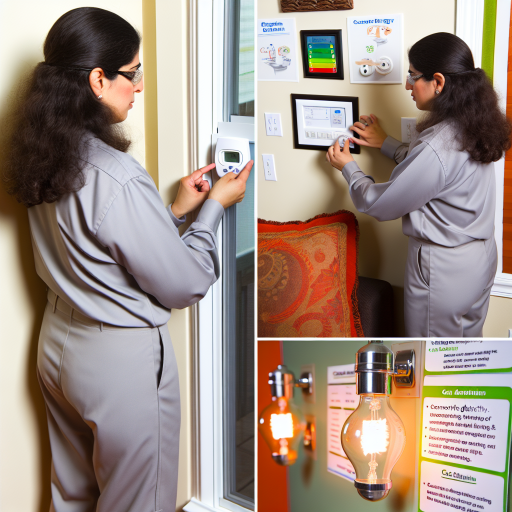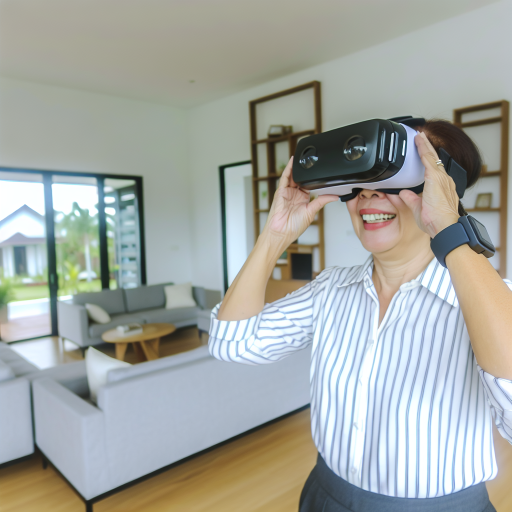Introduction to Smart Thermostats
Smart thermostats are innovative devices that enhance home heating and cooling efficiency.
They allow homeowners to control their home temperature remotely.
This is achieved through smartphone apps or web interfaces.
As a result, users can optimize energy use even when away from home.
Furthermore, these devices provide valuable energy consumption data.
By understanding usage patterns, homeowners can make informed decisions.
In turn, this leads to significant cost savings on energy bills.
Smart thermostats also adapt to users’ habits over time.
This learning capability allows them to adjust settings automatically.
Consequently, users can enjoy a consistent and comfortable environment.
Additionally, they often integrate with other smart home devices.
This synergy enhances overall home automation and control.
Many models feature voice control capabilities for added convenience.
Ultimately, smart thermostats promote energy efficiency in American homes.
Key Features of Smart Thermostats
Wi-Fi Connectivity
Wi-Fi connectivity is a crucial feature of smart thermostats.
This allows users to control their systems remotely.
With an app, homeowners can adjust settings from anywhere.
Consequently, energy use becomes more efficient.
Smart thermostats can connect to home networks with ease.
This connectivity also enables software updates.
As a result, users benefit from improved performance over time.
Remote Control
Remote control adds convenience to home heating and cooling.
Users can change temperatures without being at home.
This feature is particularly useful for busy schedules.
For example, Amanda can adjust her thermostat during her commute.
Moreover, remote control systems often include scheduling options.
Families can set specific temperatures for different times.
As a result, homes stay comfortable when occupants are present.
Learning Algorithms
Learning algorithms make smart thermostats intelligent.
These systems can analyze user habits and preferences.
For instance, Mark prefers a cooler home at night.
Therefore, the thermostat adjusts automatically based on his routine.
This feature optimizes energy use and comfort levels.
Additionally, learning algorithms can adapt over time.
Users experience increased savings on their energy bills.
Comparing Smart Thermostats to Traditional Thermostats
Understanding Traditional Thermostats
Traditional thermostats operate on a simple mechanical or electronic system.
They require manual adjustments to change temperature settings.
Homeowners often forget to make these adjustments, leading to energy waste.
These devices lack programming features found in modern technology.
Features of Smart Thermostats
Smart thermostats offer advanced features that enhance efficiency.
They provide programmable settings based on your schedule.
Users can control these devices remotely using their smartphones.
Some models even learn your preferences over time.
Efficiency Comparison
Smart thermostats significantly reduce energy consumption.
They automatically adjust the temperature when no one is home.
Traditional thermostats rely on constant temperature maintenance.
Consequently, they often result in higher energy bills.
Cost-effectiveness of Smart Thermostats
Investing in a smart thermostat can lead to long-term savings.
Many users report a noticeable reduction in utility bills.
Some utility companies offer rebates for smart thermostat installations.
In contrast, traditional thermostats incur higher operational costs over time.
Smart Thermostats Offer Superior Efficiency
Smart thermostats deliver superior efficiency compared to traditional models.
They adapt to your lifestyle, making them more convenient and cost-effective.
As energy costs continue to rise, smart technology offers a viable solution.
Find Out More: Smart Home Technology For Older Homes And Modern Retrofits
The Role of Smart Thermostats in Energy Conservation
Impact on Residential Energy Use
Smart thermostats play a vital role in energy conservation for American homes.
They utilize advanced technology to optimize heating and cooling systems.
This optimization leads to more efficient energy use overall.
Moreover, these devices learn the habits of homeowners.
As a result, they adjust temperatures based on occupancy and preferences.
This responsiveness can significantly reduce energy waste.
Smart thermostats enable users to remotely control their home climate.
Through mobile apps, homeowners can adjust settings from anywhere.
This convenience often leads to better energy management.
Additionally, many smart thermostats provide energy reports.
These reports highlight usage patterns and suggest savings opportunities.
Overall, informed users can make smarter energy decisions.
Integrating Smart Thermostats with Home Automation
Integration with home automation systems enhances their effectiveness.
This synergy creates a seamless living environment.
Smart thermostats can coordinate with other smart devices.
For example, they can work with smart blinds or lights.
Such coordination optimizes energy use further.
Furthermore, some thermostats can respond to weather forecasts.
This proactive feature adjusts settings based on outside conditions.
Consequently, homeowners can save energy during temperature extremes.
Potential Savings and Environmental Benefits
Research indicates that smart thermostats can save homeowners significant money.
On average, users see a reduction of 10-20% on heating and cooling costs.
These savings contribute to lower energy bills.
Additionally, reduced energy consumption helps the environment.
This decrease leads to a reduced carbon footprint for households.
Furthermore, energy conservation aligns with sustainability goals.
Ultimately, smart thermostats represent a win-win for users and the planet.
Discover More: Smart Home Technology For Eco-Friendly Real Estate Solutions
Popular Smart Thermostat Brands
Nest Learning Thermostat
Nest Learning Thermostat is a popular choice for many homeowners.
It learns your schedule and adjusts temperatures accordingly.
This model features a sleek design and user-friendly interface.
Additionally, it integrates seamlessly with Google Home.
Energy reports provide insights into your energy usage.
Ecobee SmartThermostat
Ecobee SmartThermostat offers enhanced control with remote sensors.
It detects occupancy to optimize heating and cooling.
Voice control capabilities come built-in, making it convenient.
This model also incorporates a built-in speaker for music streaming.
Furthermore, it is compatible with various smart home systems.
Honeywell Home T9
Honeywell Home T9 is known for its versatility and affordability.
This thermostat supports multiple zones for better temperature management.
You can control it remotely via a mobile app.
It is also compatible with both Alexa and Google Assistant.
Energy-saving modes help you save on utility bills.
Emerson Sensi Touch
Emerson Sensi Touch stands out for its easy installation process.
This thermostat features a large touchscreen display for clarity.
You can program it to fit your scheduling needs effortlessly.
Geofencing technology adjusts settings based on your location.
Moreover, it offers energy usage reports for improved efficiency.
Lux Kono Smart Thermostat
Lux Kono Smart Thermostat prides itself on its customizable design.
It allows users to change the outer wall plate for personal style.
This model is easy to use and set up within minutes.
Voice commands are supported for hands-free control.
It works with popular ecosystems like Alexa and Google Assistant.
Choosing the Right Smart Thermostat
Selecting the ideal smart thermostat depends on various factors.
Consider your home size and heating or cooling requirements.
Features like remote sensors can enhance your experience.
Additionally, think about compatibility with other smart devices.
Lastly, evaluate the design to match your home’s aesthetics.
Uncover the Details: Smart Home Technology For Real Estate Agents And Brokers

Installation and Setup: A Step-by-Step Guide for Homeowners
Preparing for Installation
Begin by choosing the right smart thermostat for your home.
Consider features like energy-saving modes and compatibility with your HVAC system.
Next, gather your tools for installation.
You will need a screwdriver, drill, and level for this task.
Powering Down Your System
Before starting, turn off the power to your HVAC system.
This step ensures safety during installation.
Locate your circuit breaker and switch off the appropriate breaker.
Removing Your Old Thermostat
Carefully detach the existing thermostat from the wall.
Take a picture of the wiring for reference.
Label the wires with tape to avoid confusion later.
Wiring the Smart Thermostat
Now, connect the wires to the new thermostat.
Match the labeled wires according to the previous setup.
Ensure all connections are secure and insulated.
Mounting the Thermostat
Attach the new thermostat to the wall using the provided screws.
Use a level to ensure it’s straight for aesthetic purposes.
Double-check that the wires are tucked neatly behind the unit.
Powering Up and Initial Setup
Turn the power back on at the circuit breaker.
Follow the on-screen prompts on the thermostat for setup.
Connect your thermostat to your home’s Wi-Fi network.
Configuring Settings
Customize your temperature preferences and schedules.
Set energy-saving modes to optimize efficiency.
Consider integrating your thermostat with smart home systems.
Testing the System
Finally, test your smart thermostat to ensure it functions correctly.
Adjust the temperature and observe the system’s response.
Make any necessary adjustments to settings for better performance.
Gain More Insights: Smart Home Technology For Home Automation Beginners
Maximizing Energy Savings with Smart Thermostats
Understanding Smart Thermostats
Smart thermostats offer significant benefits for energy savings.
They intelligently adjust your home’s temperature based on your habits.
This reduces energy consumption without sacrificing comfort.
Choosing the Right Model
Select a smart thermostat that fits your lifestyle and home design.
Consider features like scheduling, remote access, and energy monitoring.
Popular brands include Nest, Ecobee, and Honeywell.
Proper Installation
Follow the manufacturer’s instructions for installation.
Consider hiring a professional if you are unsure about wiring.
Ensure the thermostat communicates with your HVAC system properly.
Setting Up Energy-Saving Features
Take advantage of the scheduling options available.
Set your thermostat to lower temperatures during the night.
Use geofencing to adjust settings based on your location.
Regular Maintenance and Updates
Regularly check for system updates to enhance performance.
Clean your thermostat sensors to ensure accurate readings.
Check your HVAC system periodically to keep it running efficiently.
Utilizing Energy Reports
Review energy reports to understand your usage patterns.
Make adjustments based on these insights for better efficiency.
Many smart thermostats provide monthly energy summaries.
Integrating with Smart Home Systems
Connect your thermostat to other smart home devices.
This can enhance its capabilities and efficiency.
Consider integrating with home assistants like Amazon Alexa or Google Assistant.
Exploring Incentives and Rebates
Check for local or federal rebates on energy-efficient upgrades.
Many utility companies offer incentives for using smart technology.
Take advantage of these programs to save even more money.
Common Challenges and Troubleshooting Tips for Smart Thermostat Users
Connectivity Issues
Many users face connectivity problems with their smart thermostats.
This often stems from weak Wi-Fi signals.
To troubleshoot, ensure your thermostat is within range of your router.
You may also consider using a Wi-Fi extender.
Additionally, check for any network outages in your area.
User Interface Confusion
The interface of smart thermostats can be overwhelming for some users.
To overcome this, read the user manual thoroughly.
Familiarize yourself with the main functions and settings.
Take advantage of online tutorials and video guides for visual assistance.
Connecting with customer service can also clarify any confusion.
Inaccurate Temperature Readings
Some smart thermostats may deliver inaccurate temperature readings.
This could be due to improper placement of the unit.
Ensure the thermostat is installed away from direct sunlight or drafts.
Regularly recalibrating the device can enhance accuracy.
Consider using complementary sensors for better temperature management.
Integration with Other Smart Devices
Integration challenges often occur with various smart home devices.
Confirm that all devices support common protocols like Zigbee or Z-Wave.
Ensure that your hub is fully compatible with your thermostat.
If pairing fails, try resetting both devices and re-attempting the setup.
Consult the manufacturer’s website for specific integration guidelines.
Battery Issues
Battery complications can affect smart thermostat performance.
Regularly check the battery status indicator.
Replace the batteries promptly to avoid device failure.
Consider switching to a wired installation for less maintenance.
Utilizing a scheduled reminder can help you stay on top of battery changes.
Additional Resources
Smart Buildings: Using Smart Technology to Save Energy in Existing …
Presentations – Behavior, Energy & Climate Change Conference




